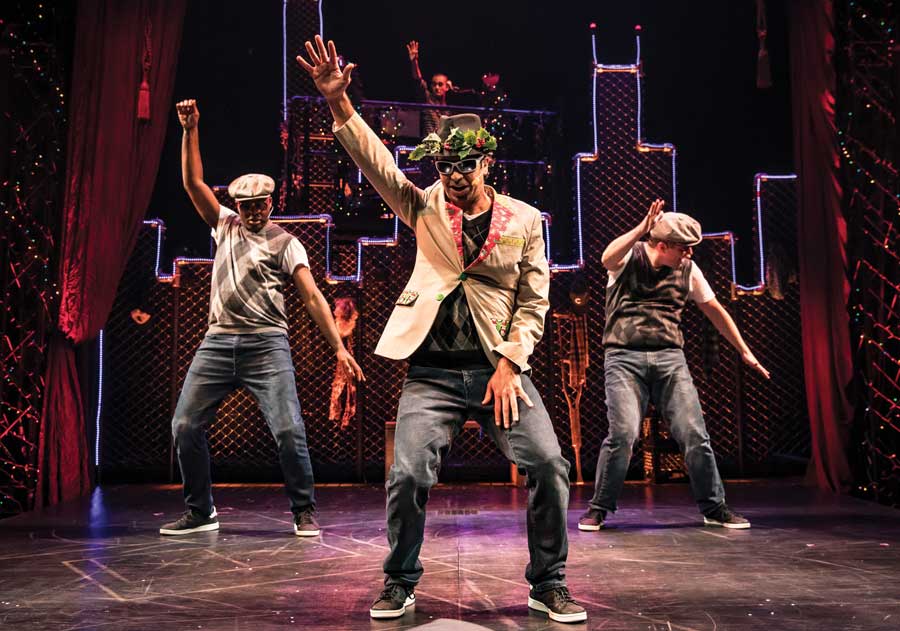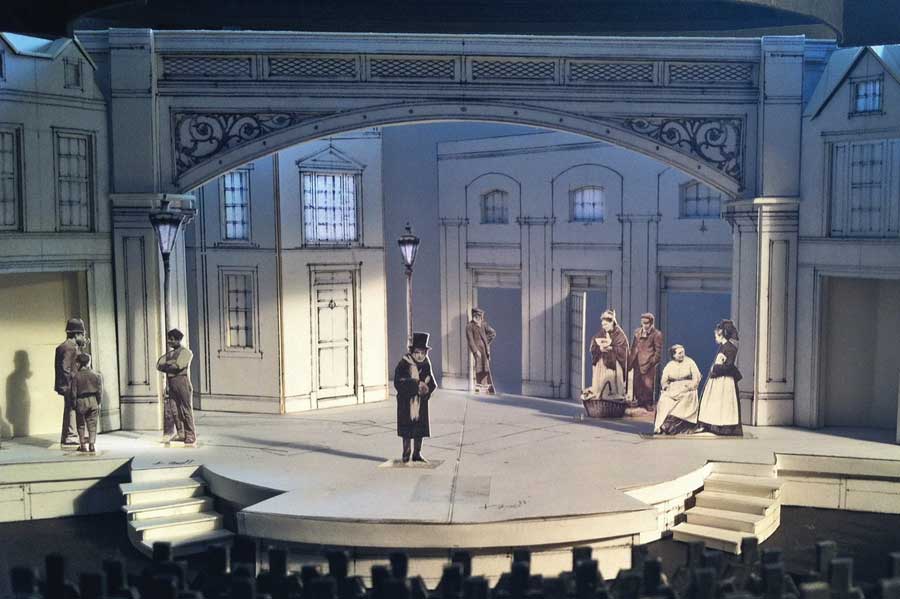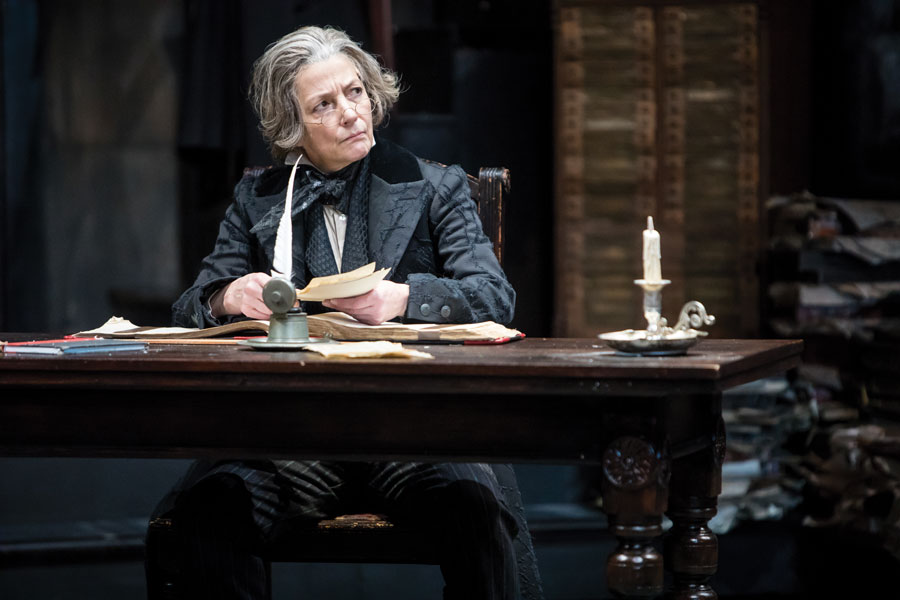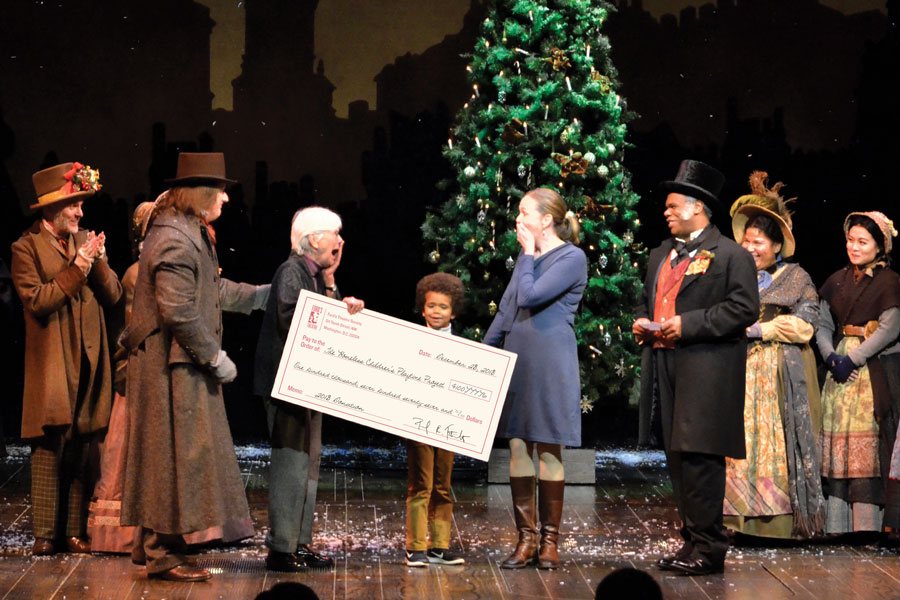It’s December, which means it’s time for Amy Herzberg’s stage adaptation of A Christmas Carol. And Patrick Mullins’s version. And Michael Wilson’s take on the tale. And, well, too many others to mention. Charles Dickens’s story has long been The Nutcracker of U.S. regional theatres; in the past, in the present, and for holiday seasons yet to come it has been and will be performed to packed houses in red states, blue states, big cities, small towns, and theatres of all shapes and sizes. (This year it’ll even be on Broadway.) It has been performed in traditional Victorian sets, in a 1920s speakeasy setting, and in modern dress; as a one-man show, as a fully cast play, and as a musical.
“It’s the greatest story ever written about forgiveness and the transformational impact we have on the world around us, for good and for bad,” says Geoff Elliott, who adapted the story for A Noise Within (ANW), the Pasadena, Calif.-based theatre he runs with his wife, Julia Rodriguez-Elliott.
“It goes to something fundamental, a philosophical and spiritual question that daily life distracts us from—what is it all for, what do I want to leave behind,” says Charles McMahon, artistic director of the Lantern Theater Company in Philadelphia, which is staging a one-man version. “The genius of Dickens’s story is it makes the stakes immediate and clear.”
Also immediate and clear from the start: the tale’s theatrical potential. The first authorized theatrical version hit the London stage in 1844, just months after the novella was published, and that February, London had eight rival versions playing. Dickens himself did more than 100 live readings, many during his 1867-68 tour of America. And it has also been adapted endlessly in every medium, from a silent film version in 1901 to a Marcel Marceau mime in 1973. In the U.S., like the holiday it’s named for, A Christmas Carol has become a big, even crucial seasonal theatre business.
The story’s public domain status means that theatres can create adaptations without shelling out licensing fees. And they’ve been doing so for the past half century: the Glendale Centre Theatre in California debuted its annual production in 1964, and the regional theatre annual tradition as we know it kicked off in the 1970s, first at the Guthrie Theater in Minneapolis (1974), then Milwaukee Repertory Theater, Kentucky’s Actors Theatre of Louisville, and San Francisco’s American Conservatory Theater in 1976, Chicago’s Goodman Theatre and Trinity Repertory Company in Providence, R.I., the following year, and Washington, D.C.’s Ford’s Theatre and Dallas Theater Center in 1979. (This last company had done it just once previously, in 1969.)
Community theatres also got in on the act, with Omaha Community Playhouse launching its annual musical adaptation in 1976, which has since toured more than 600 cities nationwide with its professional touring arm, the Nebraska Theatre Caravan, and Theatre Memphis in 1977.
(As for the three examples cited above: Herzberg’s version plays at TheatreSquared in Fayetteville, Ark., where she’s associate artistic director; Mullins’s is at the Virginia Stage Company in Norfolk, Va., where he’s an associate producer; and Wilson’s is at both the Alley Theatre in Houston and the New Stage Theatre in Jackson, Miss. Bucking the common practice whereby each theatre does its own homemade adaptation, Wilson’s version has made the rounds, having been seen by close to a million people over the years at the Alley, Hartford Stage, and Ford’s Theatre, among others.)
Some theatres program alternatives—The Santaland Diaries, A Christmas Memory, It’s a Wonderful Life, Peter Pan—that are smaller, cheaper, and/or edgier. The Arvada Center for the Arts and Humanities in Colorado, for instance, rotates shows like Elf, White Christmas, and It’s a Wonderful Life annually rather than count on a single show to draw audiences, says producing artistic director of musical theatre, Rod Lansberry. But this year, as the Denver Center for the Performing Arts is opting not to produce its annual Christmas Carol, the Arvada is stepping into the breach, producing, for the first time since 2013, the Lynn Ahrens/Alan Menken musical version that ran in New York for 11 years with celebrity Scrooges from Tony Randall to Roger Daltrey.
In most cities, though, the show is an annual ritual, deeply connected to the theatres that stage it. “It’s a big ol’ tradition here,” says Drew Fracher, who’s directing it for the ninth time at Actors Theatre of Louisville. “Three or four generations show up. You watch the same kids grow up each year.”

The show virtually guarantees strong ticket sales, with individual tickets typically sold separately from subscriptions (though often with first access and discounts offered to subscribers). At Actors Theatre, it’s responsible for between a quarter and a third of the theatre’s total annual revenue and audience, says director of marketing and communications Steve Knight.
“It’s a big part of the business model for lots of theatres,” says Tom Parrish, executive director at Trinity Rep, where the show supplies half the theatre’s annual ticket sales. “It’s a cash cow, and the income helps support the rest of the year.”
For Don-Scott Cooper the phrase “cash cow” sets his “teeth on edge,” as he feels it sends the wrong message. Now executive director of Le Petit Théâtre du Vieux Carré in New Orleans, he was previously general manager at ACT in San Francisco, where the show’s net after expenses, he points out, was just $100,000 in a $20 million annual budget. The show is “more about connecting with the community in a meaningful way,” he says, bringing in students for matinees and others who would not otherwise be able to afford it through local organizations.
“This show can’t just be for wealthy families,” agrees Mark Clements, artistic director at Milwaukee Rep, which gives away many tickets. They also raise money for charity from the stage, another common practice. At Actors Theatre, Knight says, donations are sought for Broadway Cares/Equity Fights AIDS from the stage and Toys for Tots in the lobby. In the last 10 years, Ford’s Theatre has raised nearly $750,000 for a variety of local charities serving the homeless, hungry, and impoverished.
Trisha Kirk, director of marketing at the Guthrie, says that the show is also “critical as an entry point for creating new audiences. Every year there are new 8-year-olds coming to their first show.” As Parrish points out, research shows that people develop theatregoing habits if they come as a child, especially with their parents. “It’s a learned activity.”
That’s a very long-term benefit. In the shorter term, does A Christmas Carol translate into new audiences? “It’s hard to track,” concedes ANW’s Elliott, “but anecdotally, there’ve been any number of subscribers who have told me that A Christmas Carol was the first show they saw here.”
Jason Chanos, associate artistic director at Kansas City Repertory Theatre, points out that his theatre is not generally known for family fare, which means that he doesn’t expect Carol audiences to necessarily translate into subscribers. The Guthrie’s Kirk recalls the year King Lear was the next offering after New Year’s—a tough sell after Carol. Next February’s Twelfth Night might be an easier fit. But the main goal, according to ATL’s Knight, is to get audiences to return each December.
Indeed, while it may be a box-office bonanza, the show’s large cast and often high production values can soak up a theatre’s resources and attention, leading to both weariness and wariness about continuing.
“It can be a drain,” confesses Clements, who points out that Milwaukee Rep’s production is staged in a different theatre and requires its own lighting and sound set-ups. While Carol was the big holiday attraction in town 40 years ago, the theatre now battles the Milwaukee Bucks and big-name concerts for audiences. “We must constantly question things,” he says, but he knows that stopping would cause “a severe outcry.” And while he was at first cynical about the notion of a family holiday show when he arrived at the theatre, he can now literally see its value in the faces of young children caught up in the magic of live theatre.
“Every artistic director has that moment of wondering if it’s worth it,” says Kirk. “But it is an entry point for so many people—nearly half of our audience is brand new to the Guthrie every year. And can you guarantee any other show would do that?”
Parrish says that at every theatre he’s worked at, questions are raised about the resources required to do Carol, and whether it’s on or off mission. “But this play is not just fluff—there’s meat in the story,” he says. “There’s also a flexing of technical muscles that helps the production shops and all the artists develop and grow.”
If anything, the story’s reach only seem to keep growing. Producer Tom Smedes is bringing a high-profile adaptation written by Jack Thorne and directed by Matthew Warchus from London’s Old Vic to Broadway, and he’s looking beyond just this fall. “I hope this will become a new New York tradition,” he says.
Last year Cooper brought Carol to New Orleans, a town where holiday programming “tends to be more irreverent and for adults,” he says. Offering Carol at Le Petit Théâtre “went really well. I hope it grows and becomes a tradition here.” His production’s expense, monetized over three years, is expected to lose $40,000, but after the physical production is paid off he hopes to break even. “It could become budget positive, but there are so many other reasons to do it,” he says. His artistic director sold him on it by saying that each night “somewhere out in the audience some child is having their first theatre experience.”

A very different version debuted last year at the Lantern in Philadelphia. “I would roll my eyes at the idea of A Christmas Carol,” McMahon says. “It does bring in young children and people love it. But what turns me off is that the interpretations are so treacly and cute, they take the fear out of the piece and that’s the basis of it all—it’s the terror that makes Scrooge’s journey so profound.”
The Lantern’s version is a scenery-free solo show by Anthony Lawton, who both narrates and plays all the characters. (The most notable solo edition is by Gerald Dickens, the author’s great-great grandson, whose tour this fall includes performances in eight states.) “It takes the Disney out of Dickens,” McMahon says of Lawton’s approach. “It does not sugarcoat things.” Indeed McMahon says that marketing for the show avoids phrases like “a holiday treat for the whole family,” though he thinks the 85-minute show is suitable for older children.
The Old Globe in San Diego is appealing to adults with a different approach. For two decades, its staple has been Dr. Seuss’ How the Grinch Stole Christmas! the Musical, which has been a linchpin of earned revenue and audience engagement the way Christmas Carol is for so many other theatres. But the Old Globe has a 250-seat space that has been dark each Christmas for the last decade, so artistic director Barry Edelstein decided finally to counterprogram the Grinch. Gordon Greenberg and Steve Rosen’s Ebenezer Scrooge’s BIG San Diego Christmas Show, which tells the story with five actors, a bare stage, and “tongue firmly in cheek,” is set in San Diego in 1915, where Scrooge seeks to exploit a local real estate boom; local jokes are scattered throughout. (A version of the show at the Bucks County Playhouse in Pennsylvania tailored the story to that market.) “Early sales have been massively strong,” says Edelstein, who adds that he first discussed the project with the Cygnet Theatre, a local theatre with a traditional production, to explain why he thought this wouldn’t steal their audience. “Our quiet hope is that this can become a tradition too.”

For a time-tested tradition, Dickens’s has proven remarkably flexible: At Chicago Shakespeare Theater it was reinvented by the Q Brothers Collective into a mix of reggae, dancehall, rock, and rap. But even the more conventional stagings occasionally seek to shake off the dust. The Guthrie, for instance, switched in 2010 away from an adaptation by Barbara Fields they’d used for decades to a new one by Crispin Whittell. Actors Theatre still uses Fields’s version, though Fracher has added his own touches to keep things fresh, including new scenery and a fiddle player onstage replacing the piano player to underscore scenes. He has also replaced Christian carols with more secular Victorian songs to make “everybody feel welcome,” he says—a fitting change, given that Dickens was not religious, and neither is the story.
Kansas City Rep also chucked Fields’s version in favor of a new one by Eric Rosen, then the theatre’s new artistic director. With Rosen’s departure, Chanos sought a new version and settled on Geoff Elliott’s version, which was less dialogue-heavy than the ones he saw at the Guthrie and at Costa Mesa, Calif.’s South Coast Repertory, and offered room to add a lot of music. Elliott calls his version “very, very faithful—I don’t transpose his words or water the language down.”
At Trinity, Parrish says he makes some alterations each year, to the staging if not the text. One year the show’s carolers came from an organization serving homeless children, another year from local Boys & Girls Clubs. He changes up the effects too: This year, Scrooge’s bed will fly out over the audience. “People come back because they know it’s the same show but it’s different,” he says. At other theatres he’s seen or staged a gospel version, one set in a 1920s speakeasy, one where homeless characters find and act out Dickens’s book, and one where a grandparent reads the story to the grandchildren and it comes to life.
Of course, there are always people who want everything exactly the same. In Fields’s version, Chanos says, Scrooge throws a paperweight at his nephew; we later see in a flashback that it was a gift from Scrooge’s sister, and at the end Scrooge presents it to his nephew. The new version is paperweight-less, and a few patrons told Chanos they missed those scenes. “I could only say, ‘Sorry, but we’ve got other good stuff now,’” Chanos says.
Clements says he’s had people complain about differences from the “original” story, only to realize they are referencing the Muppets movie version. Still, he acknowledges that too much change can unsettle audiences. He created a new adaptation for Milwaukee because he felt the previous version was too wordy and young children would quickly grow restless. “Thirty minutes in you’d have a steady stream to the bathroom,” he says.
So Clements, a Brit and a father who takes pride in knowing what it takes to hold a 6-year-old’s attention, beefed up the visuals—a $1 million double rotating set, more “filmic effects”—and added elements of English holiday pantomimes. “I had the ghost as Scrooge’s conscience asking the children in the audience opinions about what to do,” he says. “The kids loved it. The adults, not so much. I had pushed too far, so I had to recalibrate. There is still some audience participation, but much less of it.”

Another way to shake up the show is to change up the cast. Many casts become community icons, most famously at South Coast Repertory, which in its 40 years of the show has had just one Scrooge, Hal Landon Jr., who is retiring after this year. Many theatres have used casting to become more inclusive. The Goodman integrated in 1984, with eight African American cast members, including 7-year-old Eric Styles as Tiny Tim; in 2017, the theatre cast its first girl in the role, Paris Strickland, who is also a cancer survivor. Craig Wallace, an African American actor who played Marley’s Ghost at Milwaukee Rep and the Ghost of Christmas Past at Geva Theatre Center in Rochester, N.Y., began playing Scrooge at Ford’s Theatre in 2016, the same year Sally Nystuen Vahle took on the role at Dallas Theater Center. For the past three years at the Guthrie, Charity Jones has played Scrooge in multiple performances (alternating with Nathaniel Fuller).
“It’s important that people recognize themselves onstage,” says Clements. He recalls sitting behind several Black teenage girls during one of his productions, and they seemed disconnected until Belle, played by a Black woman, appeared. “Then they all leaned forward.”
There is always some resistance: Clements recalls one angry letter from a white supremacist so virulent the theatre alerted the police. But complaints about multicultural casting are rare, he says.

Another variable: how scary to make the show. “This year our Ghost will actually be a bunch of children in masks, which is kind of creepy,” Parrish says.
But creepy works for most productions. “I’m big on scaring the children—they seem to like it,” Fracher adds, a sentiment echoed by most, though Chanos says he is moving away from darker tones to create a show that “sees Scrooge as a lone figure in an otherwise happy world, a world that will hopefully bring him along.”
Ultimately, most stagings of A Christmas Carol have two ironclad similarities: faithfulness to Dickens’s story and characters, and a belief in the magic of fake precipitation.
“That’s one thing you cannot change,” says Parrish. “It must snow during the show. The more times it snows, the more tickets we sell, the more money we make. Some years we’ve had it snow five times.”
“It doesn’t snow in New Orleans, so when we have it snow at the end it’s a really magical moment,” Cooper says.
For many, the snow symbolizes purity of spirit and the hope of redemption, though as with all stage magic, it has a practical side. Elliott’s production uses potato flakes, which means that, as Scrooge, “by the curtain call I have mashed potatoes on my forehead.” And Clements notes that while endless snow over the orchestra seats is great fun, too much and the stage gets dangerously slippery.
Snow has earned this pride of place, Clements says, as the real thing actually boosts ticket sales. “Our box office spikes when it snows outside,” he says. “It’s like a trigger for people to make them want to come to A Christmas Carol.”
Stuart Miller, a writer based in New York City, is a frequent contributor to the magazine.


